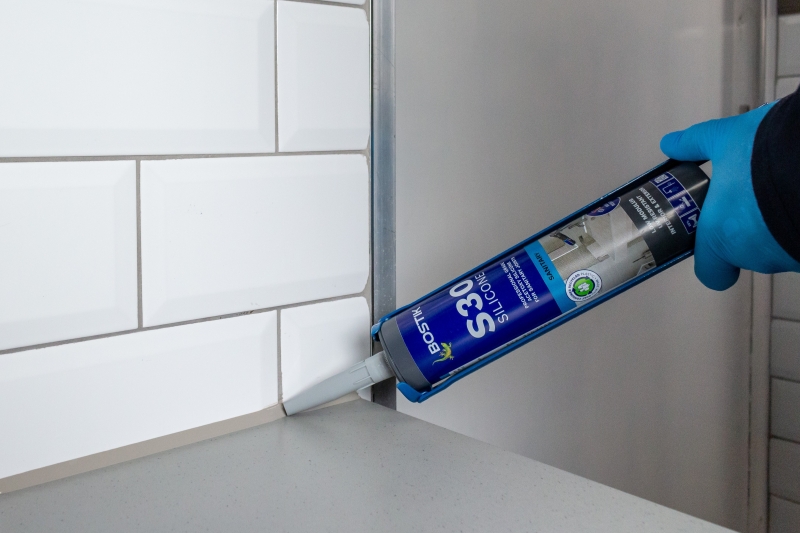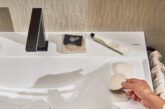
Whether you’re sealing around a new kitchen sink or updating bathroom fittings, choosing the right sanitary sealant is essential for a clean, long-lasting finish. But how do you know it’s right? The right one matches not only the challenging demands of the environment but also the materials you’re working with.
![]()
Why choosing the right sealant matters
Sanitary sealants don’t just fill gaps. They’re the first line of defence against water damage, mould growth, unsightly staining, and more – especially in the humid, enclosed environments typical of kitchens and bathrooms.
However, with today’s wide range of materials and finishes used, and the availability of different sealant technologies such as acetoxy and neutral cure silicones, not all sealants are equal. Choosing the wrong product can lead to poor adhesion, discolouration, and even damage to potentially expensive surfaces and fixtures.
Acetoxy vs neutral cure
The two main sanitary sealant technologies, acetoxy and neutral cure, both exhibit durable and proven adhesion to a variety of surfaces despite their differing chemical compositions and suitability for specific materials. So, how do they work?
Acetoxy silicones release acetic acid during the curing process, giving them their characteristic vinegar smell. They form strong, elastic rubber seals that demonstrate excellent resistance to humidity. You can use them on traditional materials such as ceramic, enamel or glass, where their bonding properties create excellent adhesion without risk of damage to surfaces. However, their acidic nature means they can corrode metals and stain porous materials, limiting their use to compatible substrates only.
When working with more modern materials such as plastics and metals, neutral cure silicone sealants come into their own. These are formulated to cure effectively in humid conditions and provide excellent adhesion without the risk of corrosion or damage to sensitive substrates. Metals, in particular, can be susceptible to corrosion if an inappropriate sealant is used. A neutral cure option helps ensure the longevity and integrity of the installation.
![]()
Porous materials, especially natural stone, require an even more careful approach. Natural stone and other porous substrates are prone to staining or soiling during application. Here, neutral cure silicones are again the preferred option, but with an important caveat: they must be non-staining and free from plasticisers to maintain the aesthetic appeal of the stone.
A simple way to check if the materials you’re working with are porous or non-porous is to add a drop of water on the surface and see if it is absorbed or beads on the surface. If it gets partially or fully absorbed, then the material is porous. If not, then it is non-porous.
Anti-mould properties
Bathrooms and kitchens often present dark and humid environments – the perfect breeding ground for mould and bacteria. Incorporating fungicides within the sealant formulation inhibits the growth of these microbes on the sealant surface, protecting not only the aesthetic quality but also the hygiene of the sealed area. Professional-grade sanitary sealants typically contain such additives to ensure a long-lasting, mould-free finish, which is essential in both domestic and commercial settings.
Fast-curing performance
The humid conditions of bathrooms and kitchens demand sealants that can cure perfectly well under humidity and skin over quickly. Extended drying times not only delay completion but also create windows of opportunity for bacteria and mould growth, as well as contamination. Dust, dirt, and airborne particles can settle on wet sealant surfaces, compromising both appearance and performance. Quality sanitary sealants will skin over in as little as 5 minutes and cure at a rate of 2-3mm per 24 hours.
Environmental considerations
The environmental impact and safety of the product should also not be overlooked. Volatile organic compounds (VOCs) are common in many sealants, and their evaporation can contribute to indoor air pollution and unpleasant odours. Selecting sealants with the lowest possible VOC content is, therefore, both a health and environmental consideration. Many modern professional sanitary silicones come with certifications such as EMICODE EC1, demonstrating their low emission levels and compliance with stringent indoor air quality standards.
Sealing sanitary joints is one of the most common applications for silicone sealants, as they repel water more effectively than other sealants. However, success hinges on matching the right technology to your specific materials and environment. Choose acetoxy silicones for traditional non-porous surfaces but opt for neutral cure when working with metals, plastics, or porous materials such as natural stone to avoid corrosion and staining.
Whatever your choice, prioritise professional-grade products with proven anti-mould properties, fast-curing performance, and low VOC content – these characteristics ensure not only a durable, hygienic seal but also better indoor air quality and reduced contamination risks during application.
For further information on Bostik, click here.







